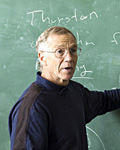Building a Topological Quantum Computer 101
Category
Published on
Abstract
Michael Freeman shares his perspective on how we should approach building a quantum computer, starting with the mathematical roots and moving through the physics to concrete engineering and materials growth challenges on which success will hinge. He will then discuss a new, enhanced, collaboration between Microsoft and Prof. Mike Manfra’s team at Purdue.
Bio
 Michael Freedman is Director of Station Q, Microsoft’s project on quantum physics and quantum computation located on the UCSB campus. The project is a collaborative effort between Microsoft and academia directed towards exploring the mathematical theory and physical foundations for quantum computing.
Michael Freedman is Director of Station Q, Microsoft’s project on quantum physics and quantum computation located on the UCSB campus. The project is a collaborative effort between Microsoft and academia directed towards exploring the mathematical theory and physical foundations for quantum computing.
Freedman joined Microsoft in 1997 as a Fields Medal-winning mathematician whose accomplishments included a proof of the 4-dimensional Poincare conjecture, the discovery (with Donaldson and Kirby) of exotic smooth structures on Euclidian 4-space, applications of minimal surfaces to topology, and estimates for the stored energy in magnetic fields. Freedman has received numerous awards and honors: The Fields Medal, election to the National Academy of Science and the American Academy of Arts and Sciences, the Veblen prize, a MacArthur Fellowship and the National Medal of Science. His work since joining Microsoft has been primarily on the interface of quantum computation, solid state physics, and quantum topology.
Sponsored by
Cite this work
Researchers should cite this work as follows:
Time
Location
121 Burton Morgan, Purdue University, West Lafayette, IN